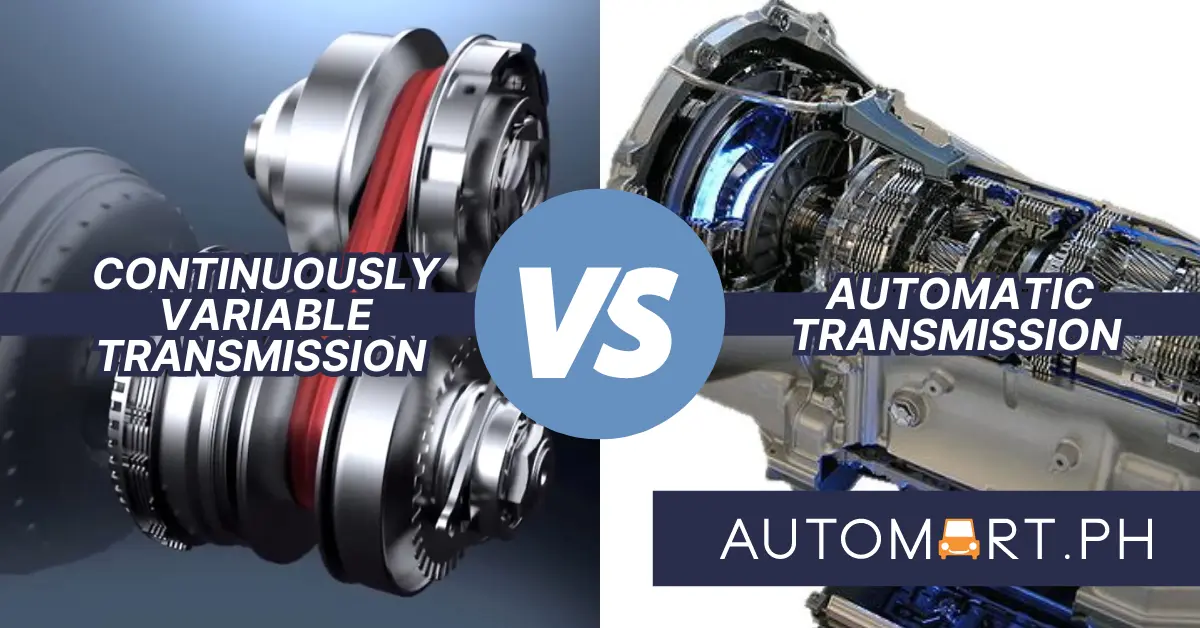
CVT vs. Automatic: The Pros and Cons
Updated on December 18 2025
Back in the not-so-distant past, car buyers choose between a manual or automatic when purchasing a car. That was then. The CVT or Continuously Variable Transmission has become the default choice for most large automakers like Honda, Nissan, Ford, Chevrolet, and Subaru, to name a few. The CVT is still a type of automatic transmission, but it doesn’t function like a conventional automatic.
What is the difference between a CVT and a conventional automatic?
As previously mentioned, the CVT is a type of automatic transmission with the same Park (P), Reverse (R), Neutral (N), and Drive (D) functions as a conventional auto. You won’t be able to tell a CVT or automatic car just by staring at the shifter or gear shift console. The working principles of a CVT go deeper than that.

The main difference between a CVT and a standard automatic gearbox is the absence of fixed gear ratios. For example, the Mitsubishi Xpander and Toyota Rush both come with a conventional four-speed automatic, meaning it has four drive gears (1,2,3,4) and a single reverse (R) gear.

In this configuration, the transmission’s hydraulic system responds to specific variables (like vehicle speed, throttle pedal position, driving mode, etc.) to select the required gear (1,2,3, or 4) without driver intervention. Put the shifter in Drive, step on the gas, and the system will choose the gears for you.

In contrast, the Mitsubishi Mirage G4 and Hatchback have a CVT automatic and have no fixed gear ratios. Like a standard automatic, the Mirage has P, R, N, and D markers in the gear selector, and driving it is as simple as piloting a conventional automatic.

The difference is when you step on the gas pedal. With no fixed gear ratios, a CVT operates more smoothly than an automatic. Utilizing a complex system of pulleys and drive belts, the CVT has an infinite number of gear ratios, very much like what you’ll find in a scooter like the Honda Click 125i. Accelerating in a CVT feels seamless since the system has no need to shift to a predetermined gear.
CVT – Pros and Cons
Pros
- The CVT is smaller and lighter than a conventional automatic transmission, helping reduce weight and save fuel.
- CVTs operate smoothly and have none of the jerkiness of a standard auto.
- It does NOT hunt for gears when climbing hills.
- CVTs offer quicker and more responsive acceleration by matching the engine’s torque output with the right ‘gear’ every time.
- CVTs will always choose the highest gear (and stay there) to save fuel.
Cons
- If you’re a sporty driver, the CVT is less engaging.
- CVTs tend to ‘drone’ or make loud noises during hard acceleration.
- Some drivers hate the ‘rubber band’ feeling of a CVT when stepping on the pedal.
- CVTs don’t last as long as an automatic (but that’s changing as we speak).
Standard Automatic – Pros and Cons
Pros
- Conventional automatic transmissions are more engaging at higher speeds.
- Automatics gives the driver a better sense of control with fixed gear ratios.
- Automatics are easier to diagnose and repair.
- Automatics are more robust.
Cons
- Less fuel-efficient than a CVT.
- Automatics hunt for gears when climbing steep, hilly roads.
- Automatic cars produce more emissions than a vehicle with a CVT.
CVT vs. Automatic: Which is better?
I’m an enthusiastic driver, but I happen to be a massive fan of CVTs. With its ability to continuously change its gear ratio at any engine speed, the CVT helps any engine achieve peak efficiency. The result is better fuel economy and a smoother drive, particularly within the city.

On the other hand, I also miss the ‘direct’ feeling of a standard automatic. But what I don’t miss is the fuel-guzzling nature of a car with a conventional automatic. However, other carmakers are working around this by improving the design and inner workings of the system.
For example, Mazda is sticking to traditional automatics with its SkyActiv-Drive auto transmission. Suzuki is the only carmaker in the Philippines to offer its AGS or Auto Gear Shift transmission in the Dzire compact sedan.

AGS is a new type of automatic transmission. It’s a five-speed manual gearbox that shifts automatically. But unlike an automatic or CVT, AGS has similar components to a manual transmission.
Should I buy a car with a CVT or should I choose an automatic?
It’s okay to choose either of the two, but it depends on what you want in a car. For a daily driver like the Toyota Vios or Mitsubishi Mirage, the CVT is hard to beat with its combination of smooth operation and sterling fuel economy.

But for certain vehicles like the Mazda 3, Mazda CX-9, or Suzuki Dzire, you can only get a standard automatic, and there’s nothing wrong with that. However, those vehicles allow you to have more fun on those open, twisty roads.